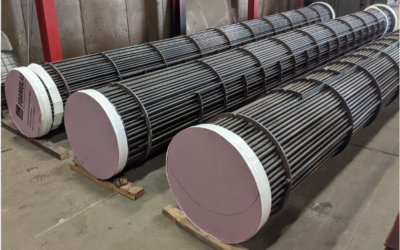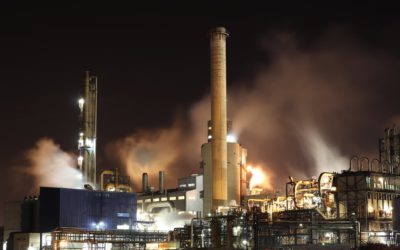HeatX Can Reduce Carbon Emissions by 200 Million Tonnes Per Year
What if the U.S. could reduce its overall carbon emissions by 180-200 million metric tonnes (MMT) per year by cleaning up a single element in how we currently produce fossil fuel-based energy?
That reduction would mean an overall Greenhouse Gas (GHG) emissions reduction of 10% for the energy sector, simply by improving efficiency.
The United States, one of the leading contributors of global GHG (Figure 1), accounts for nearly 6587 MMT of carbon dioxide equivalent (MMT CO2e) emissions in 2012 from energy consumption. While this figure is below 2007’s peak GHG emissions, the U.S. is increasingly unlikely to reach our targeted reductions of 17% below 2005 levels by the year 2020.

Failing to Hit 2020 GHG Reduction Goals
While GHG emissions have shown signs of decline over the past decade – largely due to the increased renewable energy adoption and reduced demand for energy – the current decline is not sufficient to hit reduction goals and current administration policies remain focused on fossil fuel-based energy production.
While cleaner fuels and technologies are a viable pathway to achieve the 2020 targets, there are also areas within current power generation that can be addressed to enhance the overall efficiency of the power generation and accelerate the reduction of the U.S. carbon footprint.
The energy sector relies heavily on fossil fuel combustion, contributing to 84% of total U.S. GHG emissions (Figure 2). According to the EPA, power plants alone contribute to nearly 1,876 MMT CO2e (https://www.epa.gov/ghgreporting/ghgrp-reported-data).

However, one ubiquitous piece of equipment in the energy sector would account for a massive change. The implementation of nanocomposite surface treatments can make fossil fuel-based energy production more efficient, curtailing CO2 emissions and minimizing the energy sector’s carbon footprint.
Heat Exchanger Efficiency
Power plants, oil refineries, desalination facilities, and chemical processing plants rely heavily on heat transfer equipment to recover and transfer energy throughout their operations. This equipment is the key to significant reduction in GHG emission.
Heat exchangers and condenser units in these industries suffer from fouling and corrosion which results in efficiency-loss, increased operational power usage, and significant monetary losses. In fact, most heat transfer equipment is over-engineered by 30-50 percent to accommodate efficiency losses from fouling and pumping inefficiencies.
Fouling can build up in heat exchange tubes, flow channels, and pumps, causing major losses in heat transfer capability, impeding fluid flow, causing corrosion, and creating pressure loss. Not to mention the adverse effects on operation costs, safety, health and the environment.
Mitigation of fouling in these facilities is currently limited due to the lack of technologies that have a meaningful impact on the fouling reduction and corrosion protection while not also causing reductions in the overall heat transfer efficiency of the exchanger. Thus, exchanger inefficiency, constant maintenance, and down-time/replacement are the norm. It is estimated that industrialized nations spend nearly 0.25% of GDP, or an approximate average of $4.4 billion/year, on fouling-related expenses [1].
In oil refineries, decreased efficiency of heat exchangers has been estimated to result in a nearly 10% increase in fuel usage; an increase of approximately 8 MMT per annum of CO2 emission in the oil refinery operations alone.
A typical fossil fuel-using power generation plant, which suffers from exchanger fouling, can see increases in overall CO2 output by nearly 1% due to the increased pumping and reduced heat transfer [2]. For example, up to 6.2 tons/hour of CO2 increase could be expected as a result of just 1000um (40mil) of fouling in a 550MW coal powered plant.
Desalination processes based on thermal or reverse osmosis technologies use fossil fuel electrical energy as a primary energy source. Fouling of these processes leads to increased fuel consumption to bolster pumping power. These processes account for nearly 120MMT of CO2 globally [3].
In the U.S. there is potential for at least a 10% reduction in GHG emission by effectively mitigating this fouling complication. If we can control and mitigate fouling while improving overall heat transfer, we will achieve better process efficiency for the energy sector.
Fouling & Corrosion Surface Treatment
A 10% reduction in the total GHG emission by minimizing fouling impacts makes a reduction in overall CO2 output by 180-200MMT per year possible. And that is for the energy, refining and water sectors alone. Oceanit recently completed field trials at a power plant to evaluate HeatX: an advanced, nanocomposite surface treatment developed for heat exchanger efficiency.

HeatX is a water-based, omniphobic (oil and water resistant) surface treatment that prevents fouling and scaling within heat exchangers. The treatment functions under high pressure, high temperature environments and creates an extremely slick surface that releases bio films and deposition while preventing corrosion.
Prior to HeatX, exchangers in the power plant had no fouling-prevention measures inside the tubular. Only thick layers (30 mil) of erosion-resistant epoxy coating to protect the tube sheet from sand erosion at the entrance of the exchanger.
Heat exchangers used in the field trial utilize seawater to exchange heat before returning the water to the sea. As such, the types of material used in the exchanger are regulated by EPA and state laws and it may not leach any harmful biocidal or toxic materials that could pose a threat to the marine life.
HeatX was selected for its non-biocidal, non-VOC composition, and functionality up to 400oF. The low surface energy created by HeatX would release biofouling, minimizing larger organisms, like barnacles, from binding to the exchanger surface. Furthermore, HeatX could be applied at thicknesses with no insular impact on overall heat transfer.
Oceanit applied HeatX on one of two seawater-operated shell and tube chillers (~1000 tubes ¾” diameter, 20’ length) at in December 2016. The HeatX-treated chiller has now completed 15 months of service with no interruption and was opened after six months for inspection.
During the initial six-month period, the plant monitored the seawater, auxiliary chiller water inlet and outlet temperature, and the overall power generation from the turbine associated with HeatX-treated vs. untreated chiller (Figure 3).
Inspecting the HeatX-treated chiller after six months showed a negligibly thin layer of biofilm and no signs of blockage or barnacle build-up (Figure 4). In addition, an unplanned shut down of the untreated chiller, forced the HeatX-treated chiller into action to cool down two turbines instead of one. During this period (three months), the HeatX chiller handled 2x the regular load with no signs of performance degradation.
The presence of a non-fouled heat exchanger surface allowed Oceanit’s partner to operate the exchanger at the maximum designed capacity, effectively eliminating any efficiency penalty caused by the fouling.

The direct economic benefit of foul-resistant exchanger surfaces included less downtime for equipment maintenance and savings on cost of replacement power generation. Based on the field trial it is extrapolated that HeatX could save the plant at least $1.5 million over a period of five years.
Based on the field demonstration, it is possible to achieve nearly 90% of the designed load in a heat exchanger by minimizing fouling and improving fluid flow. The HeatX ability to increase the operational load on a heat exchanger without any design modification is a profound result for heat recovery systems, effectively minimizing the energy/fuel consumption and directly reducing the GHG emission.
The anticipated benefits of the use of fouling resistant surface can be achieved in most of the existing power plant, oil refinery and desalination infrastructure with no major changes and at a fraction of cost of replacement equipment.
Ultimately, the use of HeatX can also drastically reduce the frequency of maintenance and improve the reliability of the heat transfer equipment. With current administration policies remaining focused on fossil fuel based energy production, HeatX can significantly impact the U.S. energy sector’s carbon footprint in this sector.
Works Cited:
[1] H. Müller-Steinhagen , M. R. Malayeri & A. P. Watkinson (2009) Heat Exchanger Fouling: Environmental Impacts, Heat Transfer Engineering, 30:10-11, 773-776
[2] T.Casanueva-Robles and T.R. Bott. The Environmental Effect of Heat Exchanger Fouling A Case Study. ECI Symposium Series, Volume RP2, Engineering Conferences International, Kloster Irsee, Germany, June 5 – 10, 2005
[3] WWAP (United Nations World Water Assessment Programme), The United Nations World Water Development Report 2015: Water for a Sustainable World, 2015.


